Here is a look at the NWS in-house model for precipitation through the next 5 days. Heavy totals showing up in Central, Northern Shasta County and another huge bullseye in East Butte, Western Plumas county.
Totals could approach 15-20+ inches in some of these locations.
In-house model showing the heavy rain stalling over the Northstate around 2:30 this afternoon
Heavy Rain still sitting still at 10:30 pm tonight.
At 1:30 am tomorrow morning heavy rain still training over the Northstate
3:00 am heavy rain not budging much
6:00 am heavy rain still in the Northstate
Finally by 9:00 am the rain begins to let up for the Northstate.
This image above is the forecast of 900mb winds at 1:00 am tomorrow morning. That bullseye is in the Northern half of the valley floor. 900mb is about 3000ft in altitude. So we have to do a reduction in the winds to the surface because of the friction of the earth. The rule of thumb is 15%. So if we were to take 73 knots which is about 84 mph and reduce is by about 15%, you're talking winds near 70 mph at the surface. I think we will stay below that but something to keep a close eye on.
This wrf model shows very strong south winds but below 70mph winds. However, with about 10 hours of heavy rain it is not going to take much to bring down trees in the highly saturated soils.
Next storm arrives late Friday night and it will be much weaker than today's. Yet still bringing more unneeded rain to the Northstate.
The next powerful storm arrives Saturday evening and into the overnight period. Expect another round of very heavy rain and high winds out of the south.
By Sunday afternoon the rain finally clears most of the Northstate.
Below is a list of several Sacramento River forecast near and around Red Bluff. ORANGE LINE IS MODERATE STAGE. RED LINE IS FLOOD STAGE. BLUE LINE IS CURRENT. GREEN AND PURPLE IS FORECAST RIVER HEIGHT.
River Forecast Page
River Forecast Page
Bend Bridge
Red Bluff
Vina Woodson Bridge
Tehama Bridge, Tehama




















































